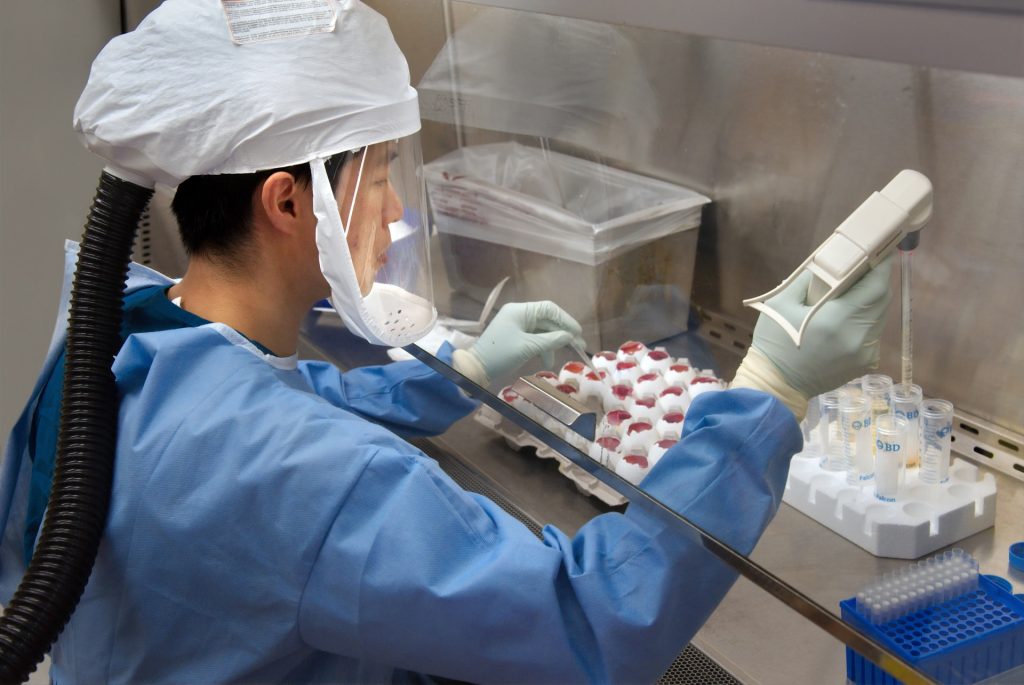
The lethal Marburg virus, a relative of the Ebola virus, causes a serious haemorrhagic fever with an extremely high fatality rate and has had no known treatment — until now.
Marburg virus infects human and primates, the disease currently has no approved vaccine or antivirals for prevention or treatment. In two larger recent outbreaks in the DRC in 1998–2000, and in Angola in 2004–2005, Marburg had extremely high fatality rates of 83% and 90%.
A team of researchers is working to change that. In a new paper in the journal Antimicrobial Agents and Chemotherapy, investigators from Penn’s School of Veterinary Medicine, working together with scientists from the Fox Chase Chemical Diversity Center and the Texas Biomedical Research Institute, report encouraging results from tests of an experimental antiviral targeting Marburg virus.
The new compound prevents viruses from leaving infected cells, thus halting the spread of infection. In a first, this new class of inhibitors was shown to be effective against infection in an animal model.
Additionally, possible similarities in virus-host interactions between Marburg and SARS-CoV-2, prompted the team to conducted experiments on the coronavirus. Unpublished preliminary results appeared encouraging.
“It really is exciting. These viruses are quite different but may be interacting with the same host proteins to control efficient egress and spread, so our inhibitors may be able to block them both,” said co-corresponding author Ronald Harty, Professor, Penn’s School of Veterinary Medicine.
Prof Harty’s team have been developing an antiviral that instead of targeting the virus known as “host-oriented.” By blocking the proteins in host cells that viruses hijack during late stages of infection, preventing virus-host interactions.
This method helps prevent a virus evolving resistance, but it also makes it more likely that a drug could be used against multiple viruses, as many make use of the same machinery in the host cell to reproduce and spread.
The Marburg and Ebola viruses use protein known as VP40 to interact with a host protein called Nedd4 to allow the completed viruses to ‘bud off’ of the host cell, which is a key part of viral replication.
Previously, they had tested a variety of small molecule inhibitors of this process using laboratory tests that relied on non-infectious and more-benign viral models. Those assays led them to a promising candidate, FC-10696, for further study.
The researchers firstly tested the chosen inhibitor for safety and its useful duration within the body. Next, since the real Marburg virus is too dangerous to study safely in anything but a Biosafety Level 4 (BSL-4) laboratory, they used an assay to look at what are known as virus-like particles, or VLPs, which are non-infectious but can bud off of a host cell.
Using the Biosafety Level 2 laboratory at Penn, “it’s a very quick way we can test these inhibitors,” said Prof Harty.
The researchers saw a dose-dependent response to FC-10696 on VLP budding in cells tested the compound using the real Marburg virus. These studies were done in a BSL-4 lab at Texas Biomedical Research Institute and found the compound inhibited the budding and spread of live Marburg virus in two human cell types, including in macrophages, an immune cell type commonly infected by the virus.
As a final step, they tested the compound in mice infected with Marburg virus. That received the treatment took longer to display disease symptoms and had a reduced viral load.
“These are the first promising in vivo data for our compounds,” said Prof Harty. “Whereas the control group all became sick very quickly and died, with the treated animals there was one survivor and others showed delayed onset of clinical symptoms. It’s showing that our inhibitors are having an effect.”
Source: News-Medical.Net
Journal information: Han, Z., et al. (2021) Compound FC-10696 Inhibits Egress of Marburg Virus. Antimicrobial Agents and Chemotherapy. doi.org/10.1128/AAC.00086-21.

